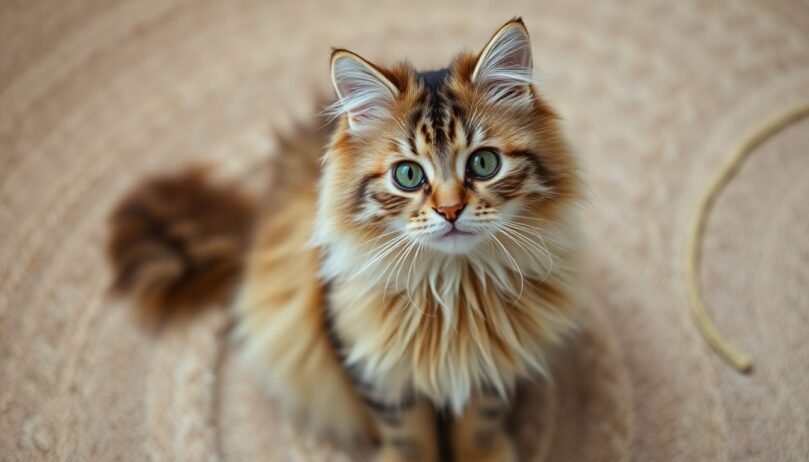Cat Bunting Behavior: What Does It Mean?
- 11 March 2025
- BuyAPet Editorial Team
- All Cats, Cat Health
Cat Bunting Behavior: Decoding Your Cat’s Affectionate Head Rubs
Ever wondered why your feline friend rubs their head against your legs—or nudges furniture with their cheeks? This behaviour, called bunting, is more than a quirky habit. It’s a form of feline communication that reveals comfort, affection, and territory. Here’s how to read it.
The Science Behind Cat Bunting: Pheromones & Scent Marking
Bunting isn’t random; it’s rooted in biology. Cats communicate with chemical signals called pheromones.
What Are Pheromones?
Pheromones are chemical messages animals use to communicate. Cats detect them with the vomeronasal (Jacobson’s) organ, located in the roof of the mouth. When investigating scents, a cat may open its mouth slightly—the classic flehmen response.
Facial Pheromones Used in Bunting
| Gland area | Where | What the scent “says” |
|---|---|---|
| Cheeks | Along the face | “This is safe and familiar.” Calm/comfort marking. |
| Chin & lips | Lower face | Mild territorial/ownership cues. |
| Forehead | Above eyes | Social bonding and affiliative intent. |
Why Do Cats Bunt? Decoding the Meanings
Claiming Territory & Marking Ownership
Bunting deposits a cat’s unique scent, signalling ownership. Other cats “read” these marks and know the space is taken. You’ll notice more object-bunting in multi-cat homes or after household changes.
Expressing Affection & Social Bonding
Head rubs with humans or other cats create a shared scent profile, reinforcing trust and group identity. Think of it as a feline “we belong together.”
Seeking Attention & Starting Interaction
Many cats learn that bunting gets a response—petting, play, or snacks. A gentle nudge can be a polite “your attention please.”
Understanding the Objects of Affection
Bunting You: A High Compliment
When your cat bunts you, it signals trust and comfort. You’re being added to their “safe and familiar” scent map—lucky you.
Bunting Furniture & Household Items
Rubbing sofas, doorways, and corners spreads familiar scents, helping cats feel grounded and reducing stress—especially after moves or redecorating.
Bunting in Multi-Cat Households
Establishing Social Order (Peacefully)
Bunting can be part of low-key hierarchy setting. A confident cat may bunt others or key locations first, signalling status without aggression.
Creating a Unified Group Scent
Mutual bunting blends scents, easing tension and promoting harmony—like everyone wearing the same team jersey.
When Can Bunting Signal a Problem?
Over-Bunting from Stress or Anxiety
A sudden spike in bunting—paired with pacing, over-grooming, or hiding—may reflect stress (new pets, visitors, furniture changes). Offer extra hiding spots, vertical space, and keep routines predictable.
Lack of Bunting
If a typically affectionate cat stops bunting and seems withdrawn or painful, it could indicate illness or discomfort. Dental, skin, or musculoskeletal issues can all reduce head/face rubbing—check in with your vet.
Practical Tips: Encouraging Calm, Happy Bunting
- Reward gentle head rubs with quiet praise or brief petting (if your cat enjoys touch).
- Keep multiple safe scent stations: stable furniture, scratchers, and resting spots your cat can mark freely.
- Maintain routines (feeding/play/sleep) to support security.
- In multi-cat homes, provide duplicates of resources (litter trays, bowls, beds) to reduce competition.
- Consider vet-recommended pheromone diffusers if stress signs persist.
FAQs
Should I rub back when my cat bunts me?
If your cat enjoys touch, a gentle cheek rub is welcome. Watch for consent cues (leaning in, purring) and back off if they stiffen or step away.
Why does my cat bunt guests?
Confident or social cats may “claim” new people as safe by adding their scent. Shyer cats may avoid bunting until they’re comfortable.
Is bunting the same as head-butting?
Bunting is usually a soft, sliding rub with cheeks/forehead. A playful “boop” can look like a head-butt, but the meaning is typically affectionate, not aggressive.
Conclusion
Cat bunting is a rich, scent-based language that communicates affection, comfort, and ownership. Notice when, where, and with whom your cat bunts—and pair that with body language and context. The better you read those head rubs, the stronger your bond will become.
